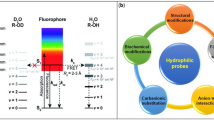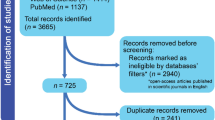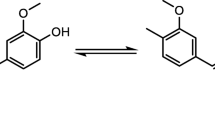Abstract
Previous reports have seldom concerned about the RTILs (Room temperature ionic liquids), and their effects on derivatization reaction or derivatives. In this study, we reported that the effects of four different RTILs, i.e., [EMIM]PF6, [BMIM]PF6, [HMIM]PF6 and [OMIM]PF6, on fluorescence spectra of 17 β-estradiol (E2), and its derivatization solvent dansyl chloride (DNSCl) and the derivative. [BMIM]PF6 had a significant quenching effect on the fluorescence intensity of E2, suggesting the formation of [BMIM]PF6/E2 complexes and possible buried E2 molecular in a more hydrophobic microenvironment. The estimated Stern-Volmer quenching constant (Ksv = 0.3519) proved that E2 quenching caused by [BMIM]PF6 was a dynamic quenching process. Four RTILs, with different alkyl chain-length in imidazolium cation, resulted in different quenching intensities to E2 as follows: [EMIM]PF6 > [BMIM]PF6 > [HMIM]PF6 > [OMIM]PF6. At 5 mg L−1 of DNSCl, [BMIM]PF6, [HMIM]PF6 and [OMIM]PF6 increased the fluorescence intensities of E2 in water by 8.5, 7.6 and 6.1 times, respectively, and a 37-nm hypsochromic shift occurred. The fluorescence intensity for [BMIM]PF6-extracted derivative of E2 increased more than two times compared with that for the control. In conclusion, this study demonstrated that above four hexafluorophosphate salt ionic liquids could be used in derivatization reaction to enhance fluorescent sensitivity in E2 trace residual analysis.





Similar content being viewed by others
References
Welton T (1999) Room-temperature ionic liquids. solvents for synthesis and catalysis. Chem Rev 99:2071–2083
Zhou Y, Antonietti M (2003) Synthesis of very small TiO2 nanocrystals in a room-temperature ionic liquid and their self-assembly toward mesoporous spherical aggregates. J Am Chem Soc 125:14960–14961
Rogers RD, Seddon KR (2003) Chemistry. Ionic liquids–solvents of the future? Science 302:792–793
Anderson JL, Armstrong DW (2005) Immobilized ionic liquids as high-selectivity/high- temperature/high-stability gas chromatography stationary phases. Anal Chem 77:6453–6462
Forsyth S, Golding J, MacFarlane DR, Forsyth M (2001) N-methyl-N-alkyl pyrrolidinium tetrafluoroborate salts: ionic solvents and solid electrolytes. Electrochim Acta 46:1753–1757
Wang LY, Chen X, Chai YC, Hao JC, Sui ZM, Zhuang WC, Sun ZW (2004), Lyotropic liquid crystalline phases formed in an ionic liquid. Chem Commun 2840–2841 (Supplementary edition)
Zerth HM, Leonard NM, Mohan RS (2003) Synthesis of homoallyl ethers via allylation of acetals in ionic liquids catalyzed by trimethylsilyl trifluoromethanesulfonate. Org Lett 5(1):55–57
Zhao C, Burrell G, Torriero AAJ, Separovic F, Dunlop NF, MacFarlane DR, Bond AM (2008) Electrochemistry of room temperature protic ionic liquids. J Phys Chem B 112:6923–6936
Armstrong DW, He L, Liu YS (1999) Examination of ionic liquids and their interaction with molecules, when used as stationary phases in gas chromatography. Anal Chem 71:3873–3876
Yanes EG, Gratz SR, Baldwin MJ, Robison SE, Stalcup AM (2001) Capillary electrophoretic application of 1-alkyl-3-methylimidazolium-based ionic liquids. Anal Chem 73:3838–3844
Fletcher KA, Pandey S, Storey IK et al (2002) Selective fluorescence quenching of polycyclic aromatic hydrocarbons by nitromethane within room temperature ionic liquid 1-butyl-3-methylimidazolium hexafluorophosphate. Anal Chim Acta 453:89–96
Tapiero H, Ba GN, Tew KD (2002) Estrogens and environmental estrogens. Biomed Pharmacother 56:36–44
Hu JY, Aizawa T (2003) Quantitative structure-activity relationships for estrogen receptor binding affinity of phenolic chemicals. Water Res 37:1213–1222
Lakowicz JR (1999) Principles of fluorescence spectroscopy, 2nd edn. Kluwer academic/Plenum, Dordrecht/New York
Fletcher KA, Pandy S, Storey IK, Pandey S (2002) Selective fluorescence quenching of polycyclic aromatic hydrocarbons by nitromethane within room temperature ionic liquid 1-butyl-3-methylimidazolium hexafluorophosphate. Anal Chim Acta 453:89–96
Deng X (2008) The preliminary study on the application of ionic liquids in fluorescent analyses Master’s thesis. Southwest University of China, Chongqing
Geng F, Zheng L, Yu L, Li G, Tung C (2010) Interaction of bovine serum albumin and long-chain imidazolium ionic liquid measured by fluorescence spectra and surface tension. Process Biochem 45:306–311
Tai SS, Welch MJ (2005) Development and evaluation of a reference measurement procedure for the determination of estradiol-17beta in human serum using isotope-dilution liquid chromatography-tandem mass spectrometry. Anal Chem 77:6359–6363
Saravanabhavan G, Hellur R, Hellou J (2002) Analysis of steroid estrogens as endocrine disruptors in mussel tissue using GC–MS techniques. In: Clement R, Burk R (eds) Proceedings of the Fourth Biennial International Conference on Monitoring and Measurement of the Environment. Toronto, Canada, pp 71–75
Nelson RE, Grebe SK, O’Kane DJ, Singh RJ (2004) Liquid chromatography-tandem mass spectrometry assay for simultaneous measurement of estradiol and estrone in human plasma. Clin Chem 50:2373–2384
Acknowledgments
This work was jointly funded by Key Project of Science and Technology Department of Zhejiang Province (2008C03001-2), Key Project of Science and Technology Department of Wenzhou City (S20060023), Natural Science Foundation of China (21077079), International Cooperation Project of Wenzhou City (H20090079) and Key project of Natural Science Foundation of Zhejiang Province (Z2080266).
Author information
Authors and Affiliations
Corresponding author
Additional information
Xuedong Wang and Yanyan Li contributed equally to this work.
Rights and permissions
About this article
Cite this article
Wang, X., Li, Y., Du, X. et al. Effects of Room Temperature Ionic Liquids on Fluorescence Characteristics of 17β-estradiol and its Derivative. J Fluoresc 21, 1643–1648 (2011). https://doi.org/10.1007/s10895-011-0853-z
Received:
Accepted:
Published:
Issue Date:
DOI: https://doi.org/10.1007/s10895-011-0853-z




